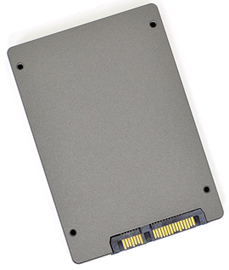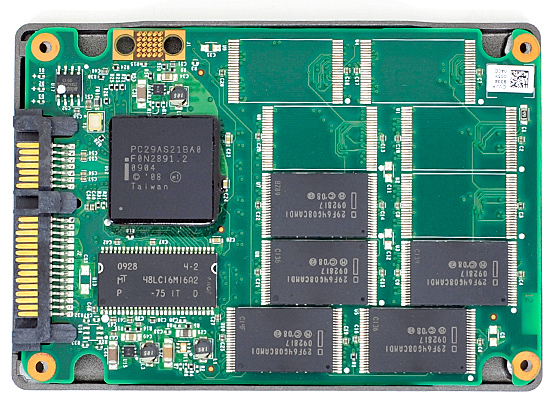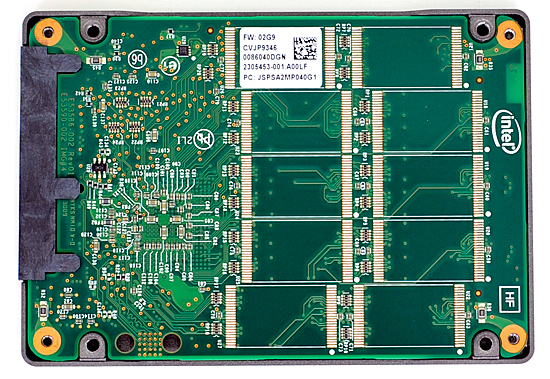The SSD Improv: Intel & Indilinx get TRIM, Kingston Brings Intel Down to $115
by Anand Lal Shimpi on November 17, 2009 7:00 PM EST- Posted in
- Storage
Kingston Delivers the First Good Sub-$100 SSD (after Rebate)
I’m not sure what sort of sweetheart deal Intel inked with Kingston, but it’s paying off. Other than Hitachi, Kingston is the only company allowed to use Intel’s controllers in their SSDs. And today, it gets even more interesting. The Kingston SSDNow V Series 40GB Boot Drive is a 34nm X25-M G2 with only 40GB of MLC NAND Flash on it.


You read that right, Kingston gets to make a 40GB X25-M G2 under its own brand.
Kingston wants this to be specifically used for your OS and applications, where the speedy launch performance of an SSD is most useful. You’d keep your games, data and other large files on a separate hard drive. Why 40GB? To keep costs down of course. The Kingston drive goes on sale starting November 9th. The MSRP of the drive will be $115 ($130 with a 2.5” to 3.5” drive adapter), Kingston is offering a rebate through Newegg that will apparently drop the price to $84.99.
Kingston’s goal was to hit the sub-$100 price point and they did it, sort of. I’m not a big fan of mail-in rebates, and it remains to be seen if Newegg can keep the drive in stock at those prices, but the intention is good.

Only 5 devices means the Intel controller works in 5-channel mode, instead of 10-channel like the X25-M G2
While the drive uses an Intel 34nm X25-M controller and 34nm flash, it doesn’t have the latest firmware from Intel, which means it doesn’t support TRIM. Since it’s technically not an Intel drive you can’t update it using the firmware I linked to earlier. The drive will most likely eventually get TRIM support, just not now. Unfortunately it doesn't even work with Intel's SSD Toolbox, again, because it's technically a Kingston drive.

With only half the NAND flash of an 80GB X25-M (only five NAND devices on board), its sequential write speeds are cut in half - Kingston rates the drive at 40MB/s. Random performance suffers a bit, but sequential write performance sees the biggest hit.
If you've already got a large hard drive for games/data and don't have that many apps installed, the Kingston 40GB SSD is a perfect way to move to an SSD affordably.










162 Comments
View All Comments
Voo - Tuesday, October 27, 2009 - link
Ok I was a bit surprised and tried it myself with my 160gb Intel G2 (no firmware update yet)Copy 10gb file onto drive, MSE full scan and extracting a 4gb file with 7z while the usual stuff (FF, PS, eclipse and winamp) running in the backgorund and I got a maximum QD of under 8, which is higher than I expected it to be, but still far away from a QD of 16.
And when doing more multitasking stuff I'd probably tax the rest of the system more than the SSD so at least for my usual behavior a QD >8 is unrealistic, but I see your point.
There are probably some people who could get a QD of 10-12 in a normal workload, so that could be interesting for them :)
GullLars - Wednesday, October 28, 2009 - link
There is a big difference between average queue and queue during operations. The IO queues are relatively low for all the background operation the OS does, and sequensial read/write, but when you do things like open administrative tools, open a program, or install something, you will se queue spikes of easily 50-60.After i commented this article i had a discussion with some other benchmarkers, and we found that normal use generates IO queue spikes almost whenever you interact with the OS. It doesn't take much effort to generate a queue above 100. Running a couple of virus scans on folders of small files while installing a program and opening a folder with lots of pictures will get you a massive queue.
NeBlackCat - Tuesday, October 27, 2009 - link
Nice work again Anand - I just don't bother reading SSD reviews/features on other sites any more.HOWEVER...
Many people reading this will be developers wondering which controller best favours typical development activities, eg. checking out and compiling large projects. It's a hard one to guess - lots of random reading, sequential reading, random writing (temp files) and sequential writing (output files).
So how about a "typical developer" benchmark of, say, compiling the Linux kernel while concurrently encoding some H.264, grepping all the sources for a string, and watching some por..er, I mean, youtube.
Has anyone else evaluated the best SSD type for s/w development?
clarkn0va - Wednesday, October 28, 2009 - link
Not a reply to your question, but I've taken on the habit of mounting my temp files to a ramdisk. Besides the speed improvement, this should help to reduce unnecessary write cycles to the SSD. Similarly, I run without swap (or page file), RAM being as affordable as it is.lamo - Tuesday, October 27, 2009 - link
TRIM support aside, I wonder how would a pair of $85 Kingston drives in a RAID 0 striped array compare against a $225 X-25M dollar/performance-wise.cosminliteanu - Monday, October 26, 2009 - link
So - "Your best bet is to install Windows 7 with your I/O controller in AHCI mode (for Intel chipsets)" this means you set in BIOS sata controller as AHCI not as IDE ?????Or just leave as IDE and after Win7 install, update intel storage driver as normal...? which is the best solution?
LuMax - Monday, October 26, 2009 - link
Can I use Intel IMSM RAID on just the data storage drives in my PC and retain TRIM functionality on the W7 Pro OS (X-25M G2) SSD?My new PC build plan was to use a single 80GB G2 for the OS and programs and two 2TB HDDs in a RAID1 array for my data/photo/video/music storage. Although I read the relevant part of this article 3 times I am still not certain if this is doable. Yes/No?
LuMax - Tuesday, October 27, 2009 - link
I heard back from Intel today:"Thank you for contacting Intel Technical Support.
I understand your question about the Intel(R) Matrix Storage Manager and the SSD. Since the drives you will be using in RAID are non-solid state disks, and the SSD you will be using will not be part of the RAID, there should not be any problem with TRIM."
somedude1234 - Tuesday, October 27, 2009 - link
I would not expect this to be possible. It sounds like you have 3 drives hanging off of the same SATA controller. You want 2 of them in RAID 1 using the IMSM driver, and one of them using the MS driver.In my experience it would be impossible to get Windows to load 2 different drivers for different ports on the same controller.
Even if they were physically independent but identical controllers (for example if you had 2 identical SAS cards plugged into the same system), as soon as you update the driver on one controller, a reboot results in all instances of that controller using the updated driver.
DoveOfTheSouth - Monday, October 26, 2009 - link
I'd like to know this too.I'm considering a similar set-up (SSD for systems drive, RAID for data storage HDD) - seems best of both worlds.